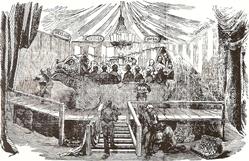 Image: The dinner in the Iguanodon, Crystal Palace, London, 1853.
Image: The dinner in the Iguanodon, Crystal Palace, London, 1853.
Geologist and science writer Nina Morgan has some suggestions for your New Year's bash
Looking for an original idea to see out the old and bring in the New Year? On the last day of 1853 the English sculptor and natural history artist, Benjamin Waterhouse Hawkins [1807–1894] – famous for his work on the life-sized dinosaur models in Crystal Palace Park in South London – faced just such a dilemma. His solution? Invite 28 of your closest colleagues to dine inside a dinosaur.
Pop-up
The venue – or as Hawkins describes it, the salle à manger – was the interior of a mould of an Iguanodon that Hawkins created as part of a display illustrating the Wealden Formation, otherwise known as the 'metropolis of the Dinosaurian order'. The Iguanodon itself was modelled on measurements taken from a specimen found by a Mr Holmes, a surgeon at Horsham in Surrey, chosen, Hawkins explained, because Holmes “bestowed much care and attention on the development of the great fossils found in his neighbourhood, among which are the largest known specimens of the bones of Iguanodon, having the greater value of being found altogether, evidently belonging to one individual."
The novelty of the venue clearly impressed the local press. Contemporary newspaper reports comment that "Often as we have recorded the proceedings of meetings and banquets convened for the purpose of giving expression of the feelings of respect and esteem for eminent and scientific men, we have never yet been called upon to record a dinner given under such circumstances ... There was something so grotesque and monstrous in the illustrations which accompanied the card: ' Mr. B. Waterhouse Hawkins requests the honour of ____'s company at dinner in the Iguanodon at 4 P.M.' which excited the curiosity and interest of some of the leading scientific men of the country, and which induced them to be present at so novel a banquet." The invitations, it is reported, were inscribed on the wing-bone of Pterodactyl.
Top table
Top of the guest list was anatomist and palaeontologist Professor Richard Owen [1804-1892], who had provided the anatomical expertise and supervised the construction of Hawkins’s life-sized cement models. Owen, the newspaper noted, was one of 21 guests who were "accommodated in the interior of the creature ", a seating arrangement Hawkins believed would best illustrate the great size of these animals. The remaining worthies were seated at a side table on a platform nearby raised to the same level.
While it may not be possible these days to invite your colleagues to welcome in the New Year by dining inside a dinosaur, surely a natural history museum near you is home to some large mounted specimens. Tea alongside a Tyrannosaurus, anyone?
Best wishes for the holiday season to all.
Acknowledgements
Sources for this vignette include: On visual education as applied to geology, by Benjamin Waterhouse Hawkins, Journal of the Society of Arts, vol 2, 1854, pp. 444-449
The Life of Richard Owen by The Rev. Richard Owen, published in 1894 and available for download from: https://archive.org/details/cu31924024760294; The Victorian 'Geological Illustrations' of Crystal Palace Park, by Peter Doyle and Eric Robinson, Proc. Geologists Association, vol 104, 1992, pp. 181-194; The Heyday of Natural History 1820-1870 by Lynn Barber, published by Jonathan Cape, 1980, and the Wikipedia entry for The Crystal Palace.
* Nina Morgan is a geologist and science writer based near Oxford. Her latest book, The Geology of Oxford Gravestones (see this month's second feature and a review in Books & Arts), is available via www.gravestonegeology.uk